Events
Laws will frequently set out facts that become true on certain events occurring, or at certain times.
Blawx's event reasoning feature is designed to allow you to make statements that reflect these truth values that change over time.
The Event Reasoning System
The Event drawer in the Toolbox has 5 blocks for events. Three are used primarily for input, and two are used primarily for queries.
All of these blocks can be thought of as dealing with a timeline that starts at "the beginning of time", and goes to "the end of time". You make statements that describe what values became true, at what points on the timeline. Blawx's even reasoning derives that a statement that became true at a given time will remain true after that time, until the opposite becomes true.
To say that something was true (or false) at the beginning of time, you use the "initially" block. To say that something was true (or false) at the end of time, you use the "ultimately" block. To say that something was true (or false) at a specific time on the timeline, you use the "From" block.
To query or test whether something was true (or false) at a given time you can use the "As Of" block. To find the widest possible periods of time during which a statement was true (or false), you use the "during" block.
Note that if you do not use the "initially" and "ultimately" blocks to specify the values at the start and end of time, Blawx will not be able to determine whether statements held from the beginning or until the end of time.
Note also that asserting something as a fact does not make it true on the timeline. If you say "socrates is mortal", and then ask whether socrates was mortal as of today, Blawx will not know. The timeline version of a statement is different from the absolute version of the statement. Similarly, if you say that "initially socrates is mortal", and then you ask whether "socrates is mortal", Blawx will not know. If you ask whether "socrates is mortal as of now", the answer will be yes, because he was initially mortal and nothing has changed that fact.
Example Life Act
The Life Act example, available from the New Project button on the Blawx home page, provides an example of how the event reasoning system can be used.
The Life Act example demonstrates how you can use the event blawx to relate the state of whether or not a person is alive to the events of that person's birth and death.
First, you can specify that a person becomes alive from the time of their birth, using the following blocks:
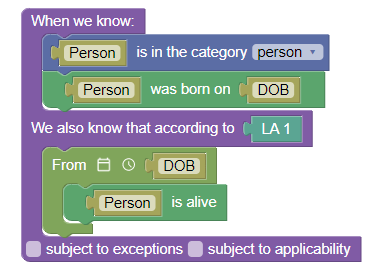
This rule states that if there is a person with a birthdate, from that person's date of birth (and thereafter) the person is alive.
In order to be able to reason about what happens prior to a person's birth, we need to indicate that at the start of time, no one is alive. That can be done as follows:
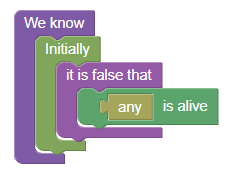
This fact, using the "any" variable selector, states that everything is not alive at the beginning of time, and stays not alive until something changes that fact. Note that you can use the logical negation of the alive block, but it is not meaningful to use the "there is no evidence" negation block in these statements. Note also that it is the statement inside the From block that is logically negated, not the From block itself.
Next we need to indicate that a person is no longer alive when they die. We create a rule very similar to the first, like this:
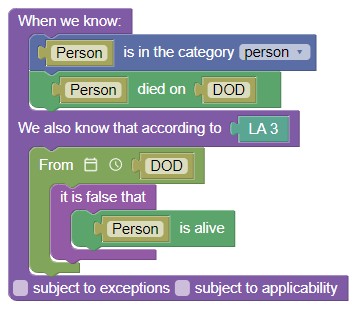
This rule follows the same pattern as the rule above. If there is a person, and that person has a date of death, then it becomes false that the person is alive as of the date of death.
We can then also say that no person lives forever by indicating that ultimately, no person is alive. That is done as follows:
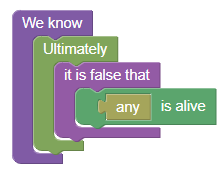
Now we have set out all of the rules that are necessary to reason about the timeline for the "alive" attribute.
We can create a fact scenario where there is a person, bob, who has a date of birth and a date of death. Then, we can ask during what periods of time is bob not alive. That code would use the "during" block, and looks like this:
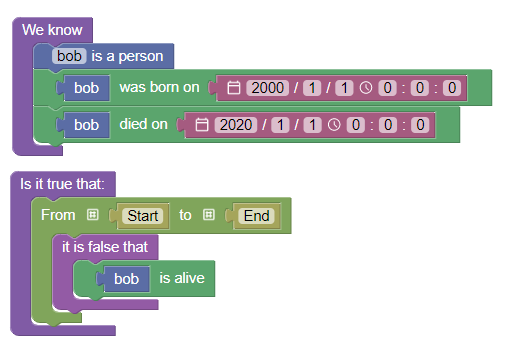
When you run this query, you will get two answers:
- Bob was not alive from the start of time until he was born.
- Bob was not alive from his death until the end of time.
If you modify the query to ask when bob was alive, Blawx can determine that he was alive from his birth date to his death date.
Known Issues
- The Blawx reasoner translates from datetimes used in the from blocks to timestamps for use in event reasoning. Currently, the method by which the datetimes are translated to timestamps will fail if the code generates datetimes from other datetimes, recursively. This will be resolved in future versions.